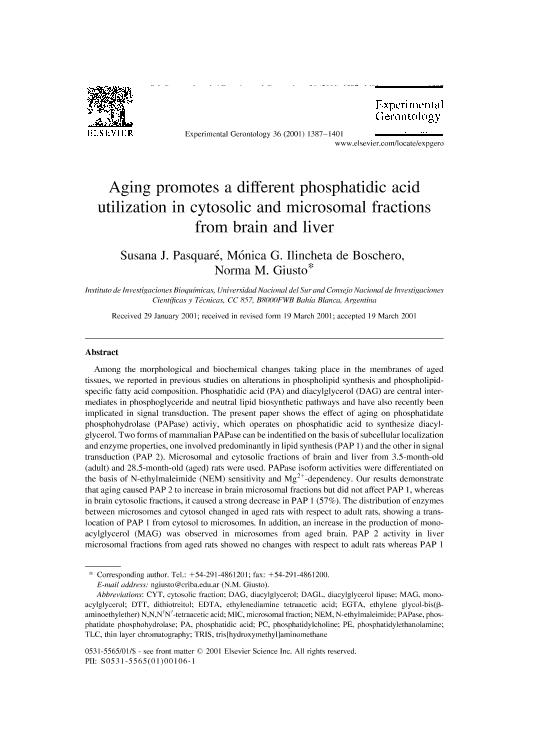Mostrar el registro sencillo del ítem
dc.contributor.author
Pasquaré, Susana Juana

dc.contributor.author
Ilincheta, Monica Graciela

dc.contributor.author
Giusto, Norma Maria

dc.date.available
2018-07-25T15:34:08Z
dc.date.issued
2001-08
dc.identifier.citation
Pasquaré, Susana Juana; Ilincheta, Monica Graciela; Giusto, Norma Maria; Aging promotes a different phosphatidic acid utilization in cytosolic and microsomal fractions from brain and liver; Pergamon-Elsevier Science Ltd; Experimental Gerontology; 36; 8; 8-2001; 1387-1401
dc.identifier.issn
0531-5565
dc.identifier.uri
http://hdl.handle.net/11336/53071
dc.description.abstract
Among the morphological and biochemical changes taking place in the membranes of aged tissues, we reported in previous studies on alterations in phospholipid synthesis and phospholipid-specific fatty acid composition. Phosphatidic acid (PA) and diacylglycerol (DAG) are central intermediates in phosphoglyceride and neutral lipid biosynthetic pathways and have also recently been implicated in signal transduction. The present paper shows the effect of aging on phosphatidate phosphohydrolase (PAPase) activiy, which operates on phosphatidic acid to synthesize diacylglycerol. Two forms of mammalian PAPase can be indentified on the basis of subcellular localization and enzyme properties, one involved predominantly in lipid synthesis (PAP 1) and the other in signal transduction (PAP 2). Microsomal and cytosolic fractions of brain and liver from 3.5-month-old (adult) and 28.5-month-old (aged) rats were used. PAPase isoform activities were differentiated on the basis of N-ethylmaleimide (NEM) sensitivity and Mg2+-dependency. Our results demonstrate that aging caused PAP 2 to increase in brain microsomal fractions but did not affect PAP 1, whereas in brain cytosolic fractions, it caused a strong decrease in PAP 1 (57%). The distribution of enzymes between microsomes and cytosol changed in aged rats with respect to adult rats, showing a translocation of PAP 1 from cytosol to microsomes. In addition, an increase in the production of monoacylglycerol (MAG) was observed in microsomes from aged brain. PAP 2 activity in liver microsomal fractions from aged rats showed no changes with respect to adult rats whereas PAP 1 activity increased 228% in microsomal fractions and 76% in cytosolic fractions in this tissue. The distribution of PAP 1 activity between microsomal and cytosolic fractions in liver tissue was also affected in aged rats, indicating a translocation of this form of the enzyme from cytosolic to microsomal fractions. The production of monoacylglycerol in liver microsomes also increased, whereas there was a decrease in MAG formation from cytosolic fraction. The changes observed in the two PAPase forms in brain and liver of aged rats with respect to adult rats suggest that PA is differently utilized by the PAPase isoforms, probably generating aging-related DAGs different to those present in adults and required for specific cellular functions. The changes observed in liver PAP 1 from aged with respect to adult rats suggest that such changes could be related with modifications in lipid homeostasis induced by age-altered hormonal balance. However, PA-modified utilization during aging through PAP 2 activity could be related to alterations in neural signal transduction mechanisms.
dc.format
application/pdf
dc.language.iso
eng
dc.publisher
Pergamon-Elsevier Science Ltd

dc.rights
info:eu-repo/semantics/openAccess
dc.rights.uri
https://creativecommons.org/licenses/by-nc-sa/2.5/ar/
dc.subject
Aging
dc.subject
Brain
dc.subject
Diacylglycerol
dc.subject
Liver
dc.subject
Phosphatidate Phosphohydrolase
dc.subject
Phosphatidic Acid
dc.subject.classification
Otras Ciencias Biológicas

dc.subject.classification
Ciencias Biológicas

dc.subject.classification
CIENCIAS NATURALES Y EXACTAS

dc.title
Aging promotes a different phosphatidic acid utilization in cytosolic and microsomal fractions from brain and liver
dc.type
info:eu-repo/semantics/article
dc.type
info:ar-repo/semantics/artículo
dc.type
info:eu-repo/semantics/publishedVersion
dc.date.updated
2018-07-11T14:10:56Z
dc.journal.volume
36
dc.journal.number
8
dc.journal.pagination
1387-1401
dc.journal.pais
Estados Unidos

dc.description.fil
Fil: Pasquaré, Susana Juana. Consejo Nacional de Investigaciones Científicas y Técnicas. Centro Científico Tecnológico Conicet - Bahía Blanca. Instituto de Investigaciones Bioquímicas de Bahía Blanca. Universidad Nacional del Sur. Instituto de Investigaciones Bioquímicas de Bahía Blanca; Argentina
dc.description.fil
Fil: Ilincheta, Monica Graciela. Consejo Nacional de Investigaciones Científicas y Técnicas. Centro Científico Tecnológico Conicet - Bahía Blanca. Instituto de Investigaciones Bioquímicas de Bahía Blanca. Universidad Nacional del Sur. Instituto de Investigaciones Bioquímicas de Bahía Blanca; Argentina
dc.description.fil
Fil: Giusto, Norma Maria. Consejo Nacional de Investigaciones Científicas y Técnicas. Centro Científico Tecnológico Conicet - Bahía Blanca. Instituto de Investigaciones Bioquímicas de Bahía Blanca. Universidad Nacional del Sur. Instituto de Investigaciones Bioquímicas de Bahía Blanca; Argentina
dc.journal.title
Experimental Gerontology

dc.relation.alternativeid
info:eu-repo/semantics/altIdentifier/doi/http://dx.doi.org/10.1016/S0531-5565(01)00106-1
dc.relation.alternativeid
info:eu-repo/semantics/altIdentifier/url/https://www.sciencedirect.com/science/article/pii/S0531556501001061
Archivos asociados
